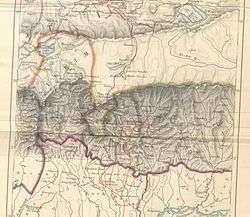Kingdom of Sikkim
| Kingdom of Sikkim འབྲས་ལྗོངས། (Sikkimese) Drenjong འབྲས་མོ་གཤོངས། (Classical Tibetan) Dremoshong ᰕᰚᰬᰯ ᰜᰤᰴ (Lepcha) Mayel Lyang | |||||||
|---|---|---|---|---|---|---|---|
| 1642–1975 | |||||||
 Historical map of Sikkim in northeastern India | |||||||
| Status |
| ||||||
| Capital | |||||||
| Common languages | |||||||
| Religion | Mahayana Buddhism | ||||||
| Demonym | Drenjop, Sikkimese | ||||||
| Government | Monarchy | ||||||
| Chogyal | |||||||
• 1642–1670 | Phuntsog Namgyal (first) | ||||||
• 1963–1975 | Palden Thondup Namgyal (last) | ||||||
| Legislature | State Council of Sikkim | ||||||
| History | |||||||
• Established | 1642 | ||||||
• Treaty of Titalia signed | 1817 | ||||||
| 1835 | |||||||
• Palden Thondup Namgyal forced to abdicate | 1975 | ||||||
• Merger with India | 16 May 1975 | ||||||
| |||||||
| Today part of |
| ||||||
| Princely state |
|---|
| Individual residencies |
| Agencies |
|
| Lists |
The Kingdom of Sikkim (Classical Tibetan and Sikkimese: འབྲས་ལྗོངས། Drenjong), earlier known as Dremoshong (Classical Tibetan and Sikkimese: འབྲས་མོ་གཤོངས།, official name until 1800s), was a hereditary monarchy from 1642 to 16 May 1975 in the Eastern Himalayas. It was ruled by Chogyals of the Namgyal dynasty.
History
Nepalese domination
In the mid-18th century, Sikkim was invaded by Nepal (then the Gorkha Kingdom) and was under the Gorkha rule for more than 40 years. Between 1775 and 1815, almost 180,000 ethnic Nepalis from Eastern and Central Nepal migrated to Sikkim. After the British colonisation of India, however, Sikkim allied itself with British India as they had a common enemy – Nepal. The infuriated Nepalese attacked Sikkim with vengeance, overrunning most of the region including the Terai. This prompted the British East India Company to attack Nepal in 1814, resulting in the Anglo-Nepalese War. The Sugauli Treaty between Britain and Nepal and the Treaty of Titalia between Sikkim and British India resulted in territorial concessions by Nepal, which ceded Sikkim to British India.[3]
British and Indian protectorate
Under the 1861 Treaty of Tumlong Sikkim became a British protectorate, then an Indian protectorate in 1950.[4]
Annexation by India
In 1975, allegations of discrimination against Nepali Hindus in Sikkim led to resentment against the Chogyal.[5][6] Their instigation led to Indian Army personnel moving into Gangtok. According to Sunanda K. Datta-Ray of The Statesman, the army killed the palace guards and surrounded the palace in April 1975.[4]
After disarming the palace, a referendum on the monarchy was held, in which the Sikkimese people overwhelmingly voted to abolish the monarchy, and the new parliament of Sikkim, led by Kazi Lhendup Dorjee, proposed a bill for Sikkim to become an Indian state, which was promptly accepted by the Government of India.[7][4]
Culture and religion
In culture and religion, Sikkim was linked closely with Tibet, from which its first king migrated, and Bhutan, with which it shares borders. The presence of a large ethnic Nepali population, mainly from eastern and central Nepal, also leads to cultural linkages with Nepal.
List of Chogyals of Sikkim (1642–1975)
See also
References
- ↑ Hiltz, Constructing Sikkimese National Identity 2003, p. 80–81.
- ↑ According to Article II of Convention of Calcutta, Sikkim was a direct protectorate of the British Government, not the British Indian government.
- ↑ "History of Nepal: A Sovereign Kingdom". Official website of Nepal Army. Archived from the original on 2011-06-07.
- 1 2 3 "Indian hegemonism drags Himalayan kingdom into oblivion". Nikkei Asian Review. Nikkei. 21 February 2016. Archived from the original on 3 April 2017. Retrieved 24 July 2018.
- ↑ Larmer, Brook (March 2008). "Bhutan's Enlightened Experiment". National Geographic. Bhutan. (print version).
- ↑ "25 years after Sikkim". Nepali Times (#35). 23–29 March 2001.
- ↑ Sethi, Sunil (18 February 2015). "Treaties: Annexation of Sikkim" (2). India Today. India Today. Retrieved 4 December 2016.
Bibliography
- Hiltz, Jackie (2003), "Constructing Sikkimese National Identity in the 1960s and 1970s" (PDF), Bulletin of Tibetology
- Rai, Rajiv (2015), The State in the Colonial Periphery: A Study on Sikkims Relation with Great Britain, Partridge Publishing India, ISBN 978-1-4828-4871-7
- Rose, Leo E. (Spring 1969), "India and Sikkim: Redefining the Relationship", Pacific Affairs, 42 (1): 32–46, JSTOR 2754861
- Rose, Leo E. (1971), Nepal – Strategy for Survival, University of California Press, ISBN 978-0-520-01643-9
- Singh, Amar Kaur Jasbir (1988), Himalayan triangle: a historical survey of British India's relations with Tibet, Sikkim, and Bhutan, 1765-1950, British Library
- Sharma, Suresh Kant; Sharma, Usha (2005), Discovery of North-East India: Geography, History, Culture, Religion, Politics, Sociology, Science, Education and Economy. Sikkim. Volume ten, Mittal Publications, pp. 117–, ISBN 978-81-8324-044-4
.svg.png)
